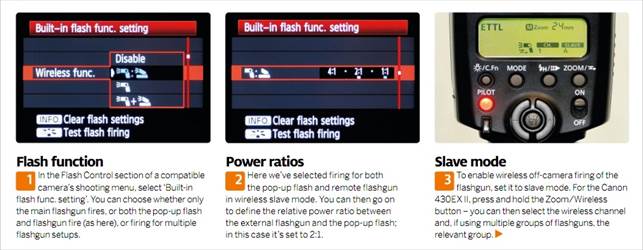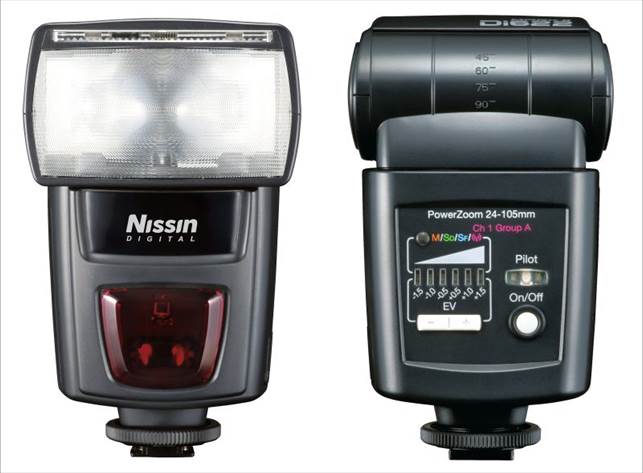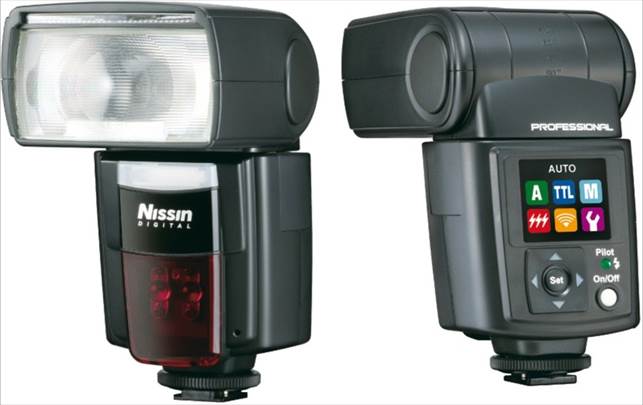New and recent cameras, including the 7D, 60D, 600D and
650D, enable you to use the pop-up flash as a wireless controller for flashguns
that have a wireless slave mode. This means you can easily use the flashgun
off-camera, to give a more three-dimensional, natural lighting effect. Check
out our step-bystep guide below to see how to set up wireless slave operation.
Apart from the Sunpak PZ42X, all the flashguns in our test
group can be used in wireless slave mode. This means you can trigger them
direct from a compatible camera, or from another flashgun that features a
wireless master mode (only the Nissin Di866 Mk II Pro and Sigma EF-610 DG Super
in this group offer this). In most cases, you can choose one of four wireless
channels, to avoid interference from other equipment or when shooting close to
other photographers who are also using wireless flash.

Step-by-step How
to go wireless for off-camera flash
Expert tip
Because of their small size and relatively close proximity
to subjects, flashguns produce very hard lighting, which is the last thing you
need for portraits. By angling the head at between 45 and 60 degrees and fitting
a diffuser, such as a Sto- Fen Omni-Bounce, you can create softer and more
flattering light. Diffusers cost around £20, with options to fit different
flashgun makes and models.
Nissin Speedlite Di622 Mk II
Despite being the joint cheapest flashgun in the group, along
with the Sunpak PZ42X, the Nissin Di622 Mk II boasts a surprisingly full set of
features, along with a marginally higher maximum power rating than the more
expensive Canon 430EX II. Plus points include a motorised zoom head with bounce
and swivel functions, a wide-angle diffuser and reflector card, and wireless
slave compatibility.

Nissin Speedlite
Di622 Mk II
Dig a little deeper, though, and a few minus points come to
light. In common with only the Sunpak in this group, recycling is anything but
silent, producing a clearly audible whining noise. The zoom motor is also quite
noisy. The wireless slave mode only works in channel 1, group A configuration
and the flashgun lacks a high-speed sync mode. There’s also no info LCD, but at
least you can apply flash exposure compensation via switches on the flashgun,
albeit only within +/-1.5EV in 0.5EV increments. Alternatively, you can apply
flash exposure compensation through the camera’s Flash Control menu.
Exposure accuracy isn’t too far off in E-TTL mode, with a
tendency to underexpose by about one-third of a stop. The recycling time after
a full-power flash is pretty nippy at 4.1 seconds.
|
Verdict
·
Price: $200 ·
For: Useful power and plentiful features considering the low
price ·
Against: Noisy in operation; lacks a high-speed sync mode; no
info LCD panel
|
Nissin Speedlite Di866 Mk II Pro
Like its smaller sibling on test, the Di866 used to be a
noisy beast, with a loud zoom motor and recycling circuitry, but the Mk II
model is more refined. It really earns its ‘Pro’ moniker too, with advanced
features including a quick-loading battery magazine, an external power input
for use with a high-capacity battery pack, a USB port for applying firmware
updates and a PC sync socket to enable triggering via a cable.

Nissin Speedlite
Di866 Mk II Pro
The Nissin boasts a stroboscopic multi-flash mode as well as
high-speed sync and rear curtain modes. Everything is wonderfully easy to get
at too, thanks to a colour LCD screen and four-way control buttons. There’s
even an orientation sensor, so the display will be the right way up during both
landscape and portrait orientation shooting. Full wireless master and slave functions
are on hand and, uniquely in the group, there’s a secondary sub-flash module,
useful for delivering direct fill-flash in bounce mode.
Exposure is consistent in E-TTL mode but proved very
slightly underexposed at -0.2 EV in our tests. Recycling is quite pedestrian
too, at 5.9 seconds. We can forgive it that, however, as the Gn rating of 60
makes it the most powerful flashgun in the group, along with the Sigma.
|
Verdict
·
Price: $350 ·
For: A feast of advanced features that you’d only expect in a
much more expensive flashgun ·
Against: Slight underexposure in E-TTL mode but at least it’s
very consistent
|